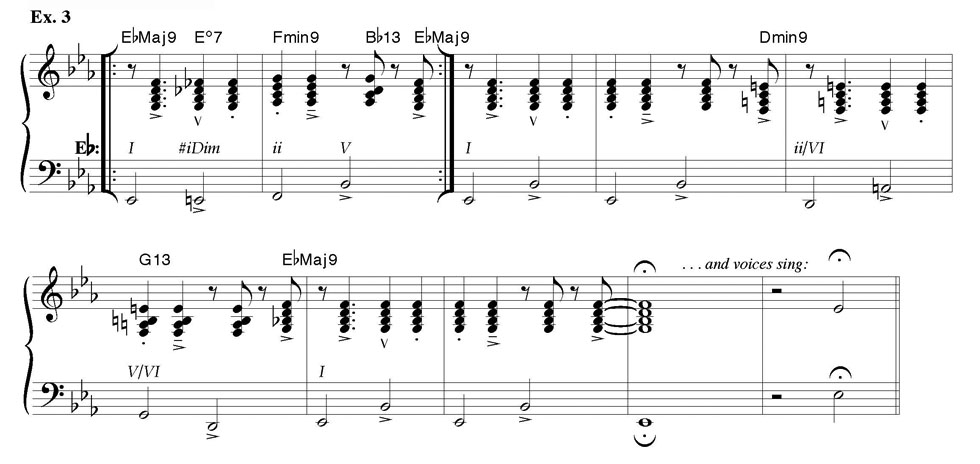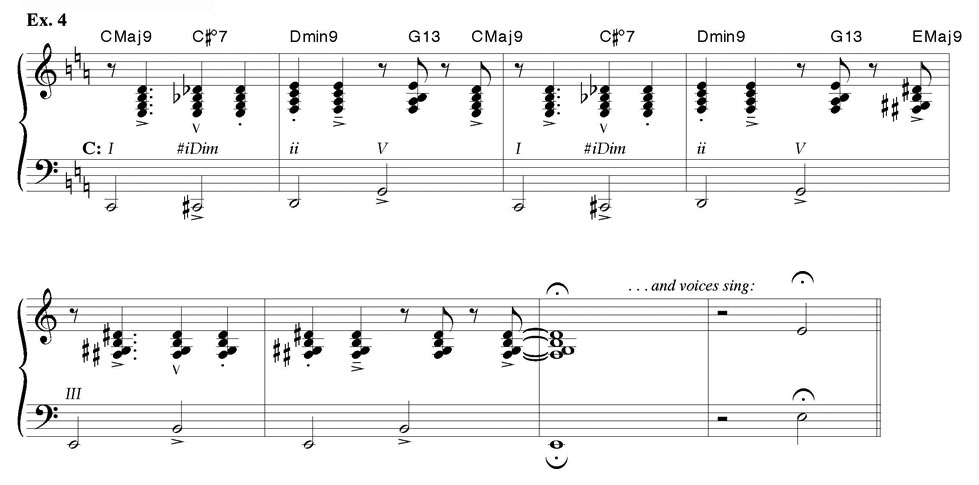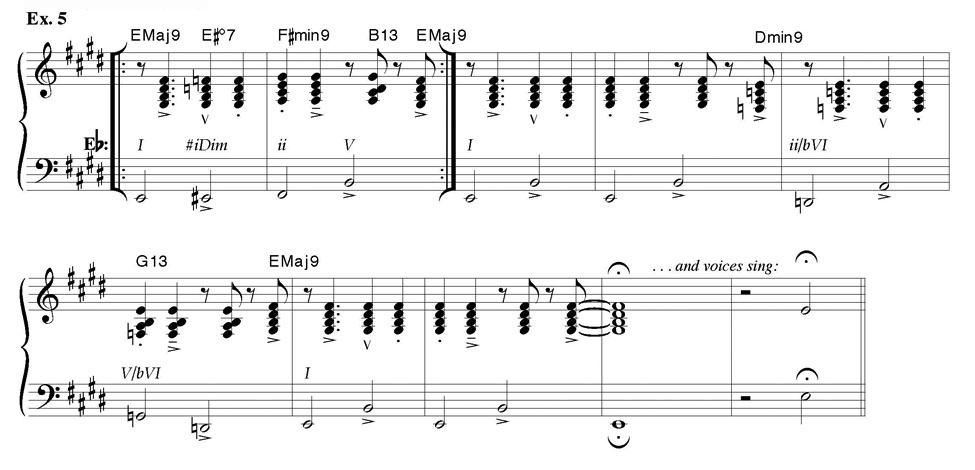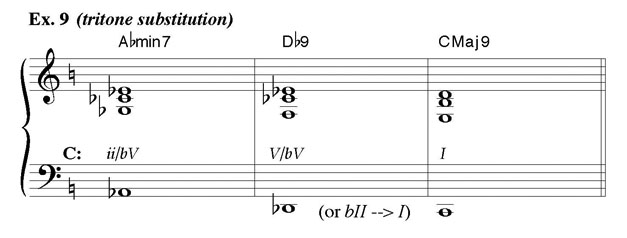Substitute
chord progressions offer some of the most riveting, colorful moments in jazz.
But how do you justify them in theory, much less improve upon them in practice?
Here is a most practical path that you can demonstrate to yourself or your
students in less than an hour.
Long before
encountering substitute chord progressions, most musicians come upon surprise
cadences (also known as substitute cadences or sub-targets). Bach chorales are
filled with countless superb examples, the simplest of which might be a V chord
that instead of resolving to a I chord goes to a vi. Sometimes the chorale
might quickly return to the key of the I chord; other times it might turn out
that the key center has changed, with what used to be the vi now the new i
chord.
To
demonstrate surprise cadences, I like to play a bossa nova progression in C
major that cadences on C as expected. I ask my students to sing the tonic note
(root of the key) to me after the final cadence—without my singing it to them. The result looks like Example
1. (Feel free to simplify the rhythms to half-notes if needed.)
Less-experienced
musicians will often sing the fifth, third, or maybe even the seventh or ninth
instead of the root of the final chord. Work with them to develop the
invaluable skill of hearing tonic: few bandstand tools are more useful than
hearing what key you’re in at a given moment!
Once
we can all agree on hearing C as tonic at the end of this progression, it’s
time to demonstrate what a surprise cadence or sub-target sounds like. In Example
2 I play the same opening but end with a two-bar statement in a
surprise key, here Eb major.
Hearing nine
beats of Eb major is usually sufficient to prompt most in attendance to sing
the Eb on their own as tonic rather than C, thus demonstrating that we have
successfully modulated to another key. And the movement is quite attractive!
Feel free to repeat the example for positive reinforcement.
And
now the logic of the progression is self-evident: if, while in the key of C, a
Dm7-G7 progression is a perfectly fine way of getting to Ebmaj7, then the same
Dm7-G7 pairing should be a wonderful means of arriving at Ebmaj7 if we’re
already in the key of Eb to begin with! Let’s test it in Example 3, where instead
of starting in C, we start in Eb.
You can demonstrate the last several bars
over and over again: it is a convincing progression.
Let’s
try one in the other direction on the circle of fifths. Play a ii-V in C that
lands on Emaj7, such as in Example 4.
Then cross over to the
mirror-image of substitute cadence: the substitute progression. If, while in
the key of C, the Dm7-G7 progression is a successful approach to Emaj7, then
the same Dm7-G7 pairing should be a fine path to Emaj7 if we’re already in the
key of E to start with. Let’s test it in Example 5, where instead of starting
in C, we start in E.
Thus a
pattern emerges, as illustrated by the chart in Example 6: the left
column’s sub-target (final chord) is the inverse-equation of the lower-fraction
in the right column. A minor third (left side) is inverse to a major sixth
(right side), a major third to a minor sixth, and so on.
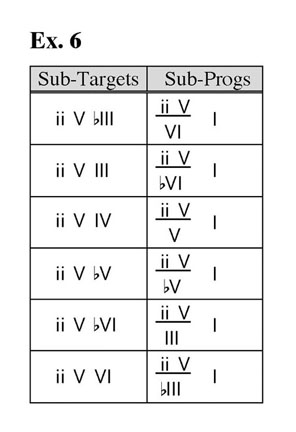 |
(No audio accompanies
this example.) |
Sub-progressions
mirror their sub-target opposites, forever related, equally viable, equally
voiceable.
Such “subs”
are accepted within the basic progressions of many jazz standards. For example,
the ii-V/bIII-I progression lives within the eighth measure of “Stella by
Starlight,” where either an Ab7 or an Ebm7-Ab7 sequence leads to a return of
the tonic Bb chord in bar nine (Example 7).
If thinking of “Just
Friends” in F, the same sequence (now Bbm7-Eb7) in measures three and four
leads to the tonic F chord in bar five (Example 8).
And the ii-V/bV-I
progression is jazz’s revered “tritone substitution” (Example 9).
The chart shown earlier in Example 6 is by no means complete; it simply opens the door to yet more possibilities,
including cadencing on minor chords: any acceptable surprise cadence can reveal
an equally acceptable substitute progression within the key of the former
surprise.
But its
applications are endless. Yes, as a composer or arranger you can learn to
employ these colors. But often overlooked is the potential for the improvising
jazz soloist, who can extemporize lines in the key of the bIII (or any other)
to create tension over a basic ii-V progression, landing when ready back in the
key of the I chord—whether the accompaniment adjusts to those new tones
or not. You’ll hear such in the performances of many renowned soloists whose
tolerance for dissonance leads to colors that are not always random
chromaticism but often organized chromaticism, freeing those soloists from the bounds of otherwise-recommended
scales for given chords. The following, extensive Example 10 (not published in the print edition of this article for lack of space but provided here as an additional notated and audio illustration) demonstrates how such a soloist might be thinking—even if the rhythm section is not making a single adjustment to complement the soloist's harmonic conception.
 |
After all,
if you follow the notion “you can play any note over any chord, so long as you
convince me” to its logical conclusion, you arrive at “you can play any chord
over any chord” as well.
Beyond the above example: if the accompanying instruments do shift some or all of their tonal centers to match in the moment the soloist's harmonic colors, the result is less dissonance between solo and comping—traded for a wildly varied set of solo changes for that chorus of the tune, inspired by the adventurousness of the soloist. Sometimes the comping instruments lead the variances, prompting the soloist to either adjust to the new harmonies or to convincingly deliver what had been diatonic solo lines now over dissonant harmonies.
With substitute progressions in play, the harmony of a standard tune can become a fountain of improvised possibilities.
_ _ _ _ _ _ _ _ _ _ _ _ _ _ _
Antonio J. García is a Professor Emeritus and former Director of
Jazz Studies at Virginia Commonwealth University, where he directed the Jazz
Orchestra I; instructed Applied Jazz Trombone, Small Jazz Ensemble, Jazz Pedagogy, Music
Industry, and various jazz courses; founded a B.A. Music Business Emphasis (for
which he initially served as Coordinator); and directed the Greater Richmond
High School Jazz Band. An alumnus of the Eastman School of Music and of Loyola
University of the South, he has received commissions for jazz, symphonic,
chamber, film, and solo works—instrumental and vocal—including
grants from Meet The Composer, The Commission Project, The Thelonious Monk
Institute, and regional arts councils. His music has aired internationally and
has been performed by such artists as Sheila Jordan, Arturo Sandoval, Jim Pugh,
Denis DiBlasio, James Moody, and Nick Brignola. Composition/arrangement honors
include IAJE (jazz band), ASCAP (orchestral), and Billboard Magazine (pop
songwriting). His works have been published by Kjos Music, Hal Leonard, Kendor
Music, Doug Beach Music, ejazzlines, Walrus, UNC Jazz Press, Three-Two Music
Publications, Potenza Music, and his own garciamusic.com, with five recorded on CDs by Rob
Parton’s JazzTech Big Band (Sea Breeze and ROPA JAZZ). His scores for
independent films have screened across the U.S. and in Italy, Macedonia, Uganda, Australia, Colombia, India, Germany, Brazil, Hong Kong, Mexico, Israel, Taiwan, and the United Kingdom. He has fundraised $5.5 million in external gift pledges for the VCU Jazz Program, with hundreds of thousands of dollars already in hand.
A Bach/Selmer trombone clinician, Mr. García serves as the
jazz clinician for The Conn-Selmer Institute. He has freelanced as trombonist,
bass trombonist, or pianist with over 70 nationally renowned artists, including
Ella Fitzgerald, George Shearing, Mel Tormé, Doc Severinsen, Louie Bellson, Dave
Brubeck, and Phil Collins—and has performed at the Montreux, Nice, North
Sea, Pori (Finland), New Orleans, and Chicago Jazz Festivals. He has produced
recordings or broadcasts of such artists as Wynton Marsalis, Jim Pugh, Dave
Taylor, Susannah McCorkle, Sir Roland Hanna, and the JazzTech Big Band and is
the bass trombonist on Phil Collins’ CD “A Hot Night
in Paris” (Atlantic) and DVD “Phil Collins:
Finally...The First Farewell Tour” (Warner Music). An avid scat-singer,
he has performed vocally with jazz bands, jazz choirs, and computer-generated
sounds. He is also a member of the National Academy of Recording Arts &
Sciences (NARAS). A New Orleans native, he also performed there with such local
artists as Pete Fountain, Ronnie Kole, Irma Thomas, and Al Hirt.
Mr. García is a Research Faculty member at The University of
KwaZulu-Natal (Durban, South Africa) and the Associate Jazz Editor of the International Trombone Association Journal.
He has served as a Network Expert (for Improvisation Materials), President’s Advisory Council member, and
Editorial Advisory Board member for the Jazz
Education Network . His newest book, Jazz Improvisation: Practical Approaches to Grading (Meredith Music), explores avenues for creating structures that correspond to course objectives. His
book Cutting the Changes: Jazz
Improvisation via Key Centers (Kjos Music) offers musicians of all ages the
opportunity to improvise over standard tunes using just their major scales. He
is Co-Editor and Contributing Author of Teaching
Jazz: A Course of Study (published by NAfME), authored a chapter within Rehearsing The Jazz Band and The Jazzer’s Cookbook (published by
Meredith Music), and contributed to Peter Erskine and Dave Black’s The Musician's Lifeline (Alfred). Within the International Association for Jazz Education he
served as Editor of the Jazz Education
Journal, President of IAJE-IL, International Co-Chair for Curriculum and
for Vocal/Instrumental Integration, and Chicago Host Coordinator for the 1997
Conference. He served on the Illinois Coalition for Music Education
coordinating committee, worked with the Illinois and Chicago Public Schools to
develop standards for multi-cultural music education, and received a curricular
grant from the Council for Basic Education. He has also served as Director of
IMEA’s All-State Jazz Choir and Combo and of similar ensembles outside of
Illinois. He is the only individual to have directed all three genres of Illinois All-State jazz ensembles—combo, vocal jazz choir, and big band—and is the recipient of the Illinois Music Educators Association’s 2001 Distinguished Service Award.
Regarding Jazz Improvisation: Practical Approaches to Grading, Darius Brubeck says, "How one grades turns out to be a contentious philosophical problem with a surprisingly wide spectrum of responses. García has produced a lucidly written, probing, analytical, and ultimately practical resource for professional jazz educators, replete with valuable ideas, advice, and copious references." Jamey Aebersold offers, "This book should be mandatory reading for all graduating music ed students." Janis Stockhouse states, "Groundbreaking. The comprehensive amount of material García has gathered from leaders in jazz education is impressive in itself. Plus, the veteran educator then presents his own synthesis of the material into a method of teaching and evaluating jazz improvisation that is fresh, practical, and inspiring!" And Dr. Ron McCurdy suggests, "This method will aid in the quality of teaching and learning of jazz improvisation worldwide."
About Cutting the Changes, saxophonist David Liebman states, “This book is
perfect for the beginning to intermediate improviser who may be daunted by the
multitude of chord changes found in most standard material. Here is a path
through the technical chord-change jungle.” Says vocalist Sunny Wilkinson,
“The concept is simple, the explanation detailed, the rewards immediate. It’s
very singer-friendly.” Adds jazz-education legend Jamey Aebersold, “Tony’s
wealth of jazz knowledge allows you to understand and apply his concepts
without having to know a lot of theory and harmony. Cutting the Changes allows music educators to
present jazz improvisation to many students who would normally be scared of
trying.”
Of his jazz curricular work, Standard of Excellence states: “Antonio García has developed a
series of Scope and Sequence of Instruction charts to provide a structure that
will ensure academic integrity in jazz education.” Wynton Marsalis emphasizes:
“Eight key categories meet the challenge of teaching what is historically an
oral and aural tradition. All are important ingredients in the recipe.” The Chicago Tribune has highlighted García’s
“splendid solos...virtuosity and musicianship...ingenious scoring...shrewd
arrangements...exotic orchestral colors, witty riffs, and gloriously
uninhibited splashes of dissonance...translucent textures and elegant voicing”
and cited him as “a nationally noted jazz artist/educator...one of the most
prominent young music educators in the country.” Down Beat has recognized his “knowing solo work on trombone” and
“first-class writing of special interest.” The
Jazz Report has written about the “talented trombonist,” and Cadence noted his “hauntingly lovely”
composing as well as CD production “recommended without any qualifications
whatsoever.” Phil Collins has said simply, “He can be in my band whenever he
wants.” García is also the subject of an extensive interview within Bonanza: Insights and Wisdom from
Professional Jazz Trombonists (Advance Music), profiled along with such
artists as Bill Watrous, Mike Davis, Bill Reichenbach, Wayne Andre, John
Fedchock, Conrad Herwig, Steve Turre, Jim Pugh, and Ed Neumeister.
The Secretary of the Board of The Midwest Clinic and a past Advisory Board member of the Brubeck Institute, Mr. García has
adjudicated festivals and presented clinics in Canada, Europe, Australia, The
Middle East, and South Africa, including creativity workshops for Motorola,
Inc.’s international management executives. The partnership he created between
VCU Jazz and the Centre for Jazz and Popular Music at the University of
KwaZulu-Natal merited the 2013 VCU Community Engagement Award for Research. He
has served as adjudicator for the International Trombone Association’s Frank
Rosolino, Carl Fontana, and Rath Jazz Trombone Scholarship competitions and the
Kai Winding Jazz Trombone Ensemble competition and has been asked to serve on
Arts Midwest’s “Midwest Jazz Masters” panel and the Virginia Commission for the
Arts “Artist Fellowship in Music Composition” panel. He was published within the inaugural edition of Jazz Education in Research and Practice and has been repeatedly
published in Down Beat; JAZZed; Jazz
Improv; Music, Inc.; The
International Musician; The
Instrumentalist; and the journals of NAfME, IAJE, ITA, American
Orff-Schulwerk Association, Percussive Arts Society, Arts Midwest, Illinois
Music Educators Association, and Illinois Association of School Boards.
Previous to VCU, he served as Associate Professor and Coordinator of Combos at
Northwestern University, where he taught jazz and integrated arts, was Jazz
Coordinator for the National High School Music Institute, and for four years
directed the Vocal Jazz Ensemble. Formerly the Coordinator of Jazz Studies at
Northern Illinois University, he was selected by students and faculty there as
the recipient of a 1992 “Excellence in Undergraduate Teaching” award and
nominated as its candidate for 1992 CASE “U.S. Professor of the Year” (one of
434 nationwide). He is recipient of the VCU School of the Artsí 2015 Faculty Award of Excellence for his teaching, research, and service and in 2021 was inducted into the Conn-Selmer Institute Hall of Fame. Visit his web site
at <www.garciamusic.com>.
If you entered this page via a
search engine and would like to visit more of this site, please
click | Home
|.


